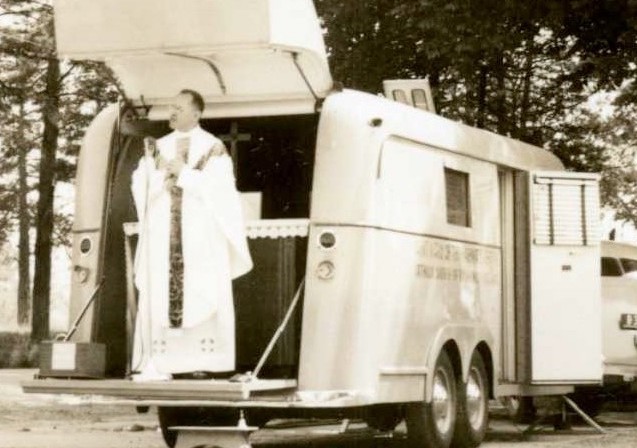Parish ‘family’ enjoys safe, comfortable sanctuary
Making more than $100,000 in improvements may seem daunting to many parishes, but it is particularly impressive for the Shrine of the Infant Jesus of Prague, Wakefield, which has only 17 registered families.
According to the Diocese of Richmond’s “Shine Like Stars” bicentennial book, the small parish was established in 1948 to fulfill a promise made by Larry Monahan.
As he was hitchhiking around the country, Monahan bought the Virginia Diner in Wakefield and promised St. Jude that he would start a Catholic church in the area if his business were successful. It was.
At first, the few Catholics in the area worshiped in a “mission trailer” that came to town, St. Mary of the Highways Chapel. When the number of parishioners outgrew the trailer, the Monahans opened their home until the present church was built across from his restaurant in 1953.
Recently the church needed a multitude of repairs.
Several maintenance projects were scheduled as a multi-prong effort to reduce moisture in the church that was causing discoloration on the inside walls and rafters, and deterioration of the masonry. It is believed the moisture came from ambient humidity, water osmosis from surrounding soil, and water in the underground boiler room, which was constantly flooded due to water in the chimney and hydrostatic pressure on the walls.
The recently completed parking lot had been built at a higher elevation than the church, so rain would flow from it and run into the church walls, saturating the surrounding soil. When the church was built, it had copper downspouts and copper gutters, but at some point, the downspouts were removed and the gutter drains filled with soil, explained John Walters, project coordinator.
As part of the recent improvements, the church interior was cleaned, the church property was regraded to redirect drainage from the parking lot, and a rock bed was placed around the church to better redirect rainwater.
Gutters were installed along the roofline, a foundation drain, also called a French drain, and a downspout drain were installed to divert rain. A replacement sump pump with a backup battery, discharge line and channeling system was installed, and the walls were draped with a non-porous material, directing water that seeps through the walls to the sump.
Additionally, a chimney cap was mounted to direct even more water away from the church, and a high-efficiency HVAC system replaced the air conditioner and LP-fired heating system to reduce the ambient humidity and to be more ecological in support of the pope’s encyclical on the environment, Walters said.
“The boiler room is such a stark improvement over what it was. There were times that you would go down there and find three feet of water in that room, and now it is almost bone dry,” Walters said.
The parish is in the process of fixing electrical problems, and it plans to repair the marble steps on the altar. The three exterior doorways will be replaced because they have pulled away from the church foundation and deteriorated.
The parish will repair the stained glass window and replace its protective covering, which has become opaque with age and prevents one from recognizing the Infant Jesus of Prague image from the church exterior, Walters added.
The parish began analyzing what work needed to be done in March, and Walters expects all of it to be completed by the end of the year. He expects the maintenance projects to reach $120,000 by the time they are finished. The parish paid for the improvements with money from investments, a nest egg that came from contributions in excess of parish expenses over the years, Walters said.
He described the parish as a friendly, “very communal entity” that seems to appreciate all that has been done to renovate the church that many call home.
Karen Capps, Lois Klapetzky and Marilynn Tench are just three of the parishioners who verified that sentiment.
“Everyone is more comfortable in this church. We can breathe easier because I feel there’s not as much moisture in the air,” Capps said.
“The improvements have made our church better and more comfortable in the sanctuary,” Klapetzky said.
“The improvements are wonderful!” said Tench. “It’s safe now.”
Father Emmanuel “Tabi” Mensah, pastor, said it was important to “maintain that beautiful church” for posterity.
That’s important to those belonging to the quaint church as well. The community is so close-knit that if one person doesn’t attend Mass, they can expect a phone call from at least one other parishioner to ensure they are OK, Tench said.
For some, other churches are closer to home than the shrine, but they make the drive anyway because they enjoy its sense of family.
“The camaraderie and fellowship in this church is unbelievable. It’s a small church, and everyone knows each other,” Klapetzky said.
Similarly, Capps said she attended a different church before joining the shrine but found the latter to be more inviting.
“After coming here, I’ll never leave,” she said. “This parish has made me feel like I belong, and it’s like a big family here.”
Although the parish is small, it is not exclusive.
“The people are so friendly, and we love it,” said parishioner Gordon Tracy. “We’ll be reaching out to other Catholics who do not belong to another parish. We want to expand our congregation.”

